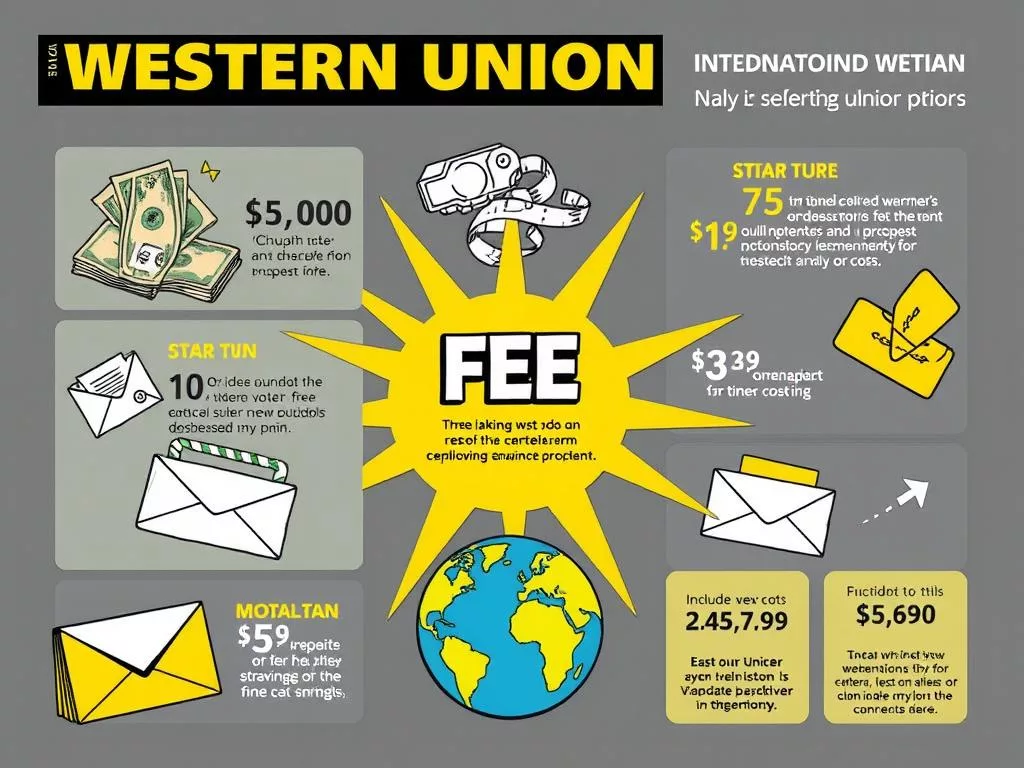Understanding Western Union fees is key for those sending money globally. With over 57,000 locations in the U.S., Western Union handles both domestic and international transfers. The costs can differ a lot. Domestic fees are between $20 to $35, and international fees are $35 to $50 on average.
Incoming wire transfer fees can be from $0 to $16. Fees change based on payment method, currency, and transfer location.
Transaction limits also vary. Unverified accounts can send up to $3,000, and verified accounts up to $50,000. Western Union offers online calculators to help estimate costs. Knowing these fees and exchange rates helps you make better money sending decisions.
Understanding Western Union’s Money Transfer Fees
Western Union is a well-known name in money transfers, helping over 150 million people worldwide. To get the most out of it, knowing the fee structure is key. The cost of sending money can change based on several factors, leading to a detailed fee breakdown.
There are two main fees: outgoing and incoming. These fees can range from $0.00 to $61.00, depending on the method and amount. For instance, wire transfers might cost $0.65 to $3.76 for every $100 sent. Fees differ by location, with Canada’s fees between 0.5% to 4% and India’s starting at 2% of the total amount.
Another important factor is the exchange rate markup. Western Union adds a markup of 0.4% to 7%+ on exchange rates. This can make the fees higher than expected. For example, sending USD to GBP has a 1.6% markup, while USD to INR has around 7% markup. Knowing this can help you make better choices.
For international transfers, intermediary fees might also apply. These fees can change based on banking relationships. They add to the total cost. The fees depend on the service used, payment method, and the recipient’s options.
Understanding Western Union’s fee structure and types of fees can help you make smart money sending choices. For more detailed guidance, check out this quick transfer guide to improve your knowledge.
| Transfer Type | Average Fees | Exchange Rate Markup |
|---|---|---|
| Outgoing (USA) | $0.65 – $3.76 per $100 | 0.4% – 7% |
| Incoming (Canada) | 0.5% – 4% | Varies |
| Incoming (India) | Minimum 2% | 7% |
Guide to how much is the western union fee
Knowing the costs of using Western Union for money transfers is key. The Western Union fee guide shows how fees change based on several things. This includes the countries involved, the amount being sent, and how you pay.
Online transfers are usually cheaper than going to a store. This is because in-person options often have extra fees.
By late 2024, sending money within the US could cost between $0.99 and over $50. Sending money abroad could cost from $0.99 to more than $129.99. For instance, sending $1,000 from the US to India can cost between $0.99 and $34.00, depending on your choices.
The table below shows different Western Union fees for various transfer methods and places:
| Transfer Method | Domestic Fee Range | International Fee Range | Transfer Speed |
|---|---|---|---|
| Online Bank Transfer | $0.99 – $4.99 | $0.99 – $34.00 | Minutes to 5 Business Days |
| Cash Pickup | $2.50 – $50 | $9.99 – $129.99 | Minutes |
| Debit/Credit Card | $3.99 – $50 | $5.00 – $100 | Minutes to 4 Business Days |
To manage transferring money costs well, use Western Union’s fee estimator. This tool helps you see possible fees based on your needs. It makes comparing fees easier, helping you save money.

Additional Costs to Consider with Western Union
When you use Western Union for money transfers, it’s key to know about extra costs. The main fees are often shown, but hidden ones can add up. This can change how much your transfer costs. Here are some things to remember:
- Exchange Rate Markups: Western Union often charges more than the market rate. Always check the rates they offer and compare them to the current market rates.
- Credit/Debit Card Fees: Using cards to fund transfers can lead to extra fees from your bank. This can increase the total cost of your transaction.
- Intermediary and Correspondent Bank Fees: If your transfer goes through banks in between, you might face unexpected fees. This can make the total cost higher.
- Cancellation or Modification Fees: If you need to change or cancel a transfer, you might have to pay extra. These fees can add up quickly.
It’s smart to do your homework to find out all the fees. Knowing this helps you manage your money better and make smart choices. For example, some countries let you send up to $50,000, but most are capped at $5,000. You also need to verify your identity if you’re sending over $3,000 in the U.S. This adds to the complexity of the process.
| Cost Factor | Details |
|---|---|
| Transaction Fees | $0.65 to $3.76 per $100 sent |
| Exchange Rate Markups | May vary significantly; often less favorable than market rates |
| Credit/Debit Card Fees | Possible additional fees from financial institutions |
| Intermediary Bank Fees | Unpredictable costs if involving third parties |
| Cancellation Fees | Potential fees applied for alterations |

Knowing about these costs can help you avoid surprises. You can also use this guide to save money on currency exchange. This can help you make more economical choices for your money transfers.
How to Minimize Your Western Union Transfer Fees
Looking to save on Western Union fees? There are ways to make your money transfers cheaper. First, compare different transfer options. This can help you find services with better fees for your needs.
Online transfers are often cheaper than in-person ones. They can save you money if you send money often. Also, ACH transfers might take longer but cost less than wire transfers. Always check the exchange rates to avoid high fees.
Choosing the right payment method is also important. Bank account payments usually cost less than credit card payments. By following these tips, you can cut down on Western Union costs. For more tips, visit Western Union transfer fees.

